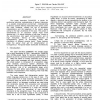SPE
2008
14 years 10 days ago
2008
Programmers tend to avoid using language tools, resorting to ad-hoc methods, because tools can be hard to use, their parsing strategies can be difficult to understand and debug, a...
CORR
2010
Springer
14 years 16 days ago
2010
Springer
The complexity of sentences characteristic to biomedical articles poses a challenge to natural language parsers, which are typically trained on large-scale corpora of non-technica...
IJCAI
1989
14 years 1 months ago
1989
This paper describes SYNAPSIS, a parser for performing real-time understanding of spoken utterances in a parallel computational environment. Understanding continuous speech allowi...
ANLP
1992
14 years 1 months ago
1992
This paper presents a system which detects and corrects morpho-syntactic errors in Dutch texts. It includes a spelling corrector and a shift-reduce parser for Augmented Context-fr...
AAAI
1992
14 years 1 months ago
1992
We describe an approach to training a statistical parser from a bracketed corpus, and demonstrate its use in a software testing application that translates English speci cations i...
ANLP
1997
14 years 1 months ago
1997
We describe a practical parser for unrestricted dependencies. The parser creates links between words and names the links according to their syntactic functions. We first describe ...
CLIN
2000
14 years 1 months ago
2000
Ever since the landmark paper Ramshaw and Marcus (1995), machine learning systems have been used successfully for identifying base phrases (chunks), the bottom constituents of a p...
ANLP
2000
14 years 1 months ago
2000
We present an efficientmulti-levelchart parser that was designed forsyntacticanalysisofclosedcaptions (subtitles) in a real-time Machine Translation (MT) system. In order to achie...
ACL
2001
14 years 1 months ago
2001
We present two language models based upon an "immediate-head" parser -our name for a parser that conditions all events below a constituent c upon the head of c. While al...
EMNLP
2004
14 years 1 months ago
2004
Accurate dependency recovery has recently been reported for a number of wide-coverage statistical parsers using Combinatory Categorial Grammar (CCG). However, overall figures give...





